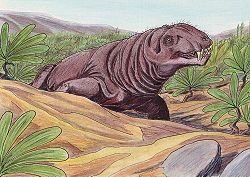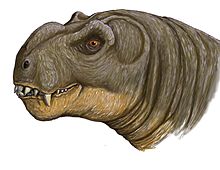- Deuterosaurus
-
Deuterosaurus
Temporal range: Capitanian
Deuterosaurus biarmicus Scientific classification Kingdom: Animalia Phylum: Chordata Class: Synapsida Order: Therapsida Suborder: Dinocephalia Superfamily: Anteosauroidea Genus: Deuterosaurus
Eichwald, 1860Species D. biarmicus
D. gigas
D. jubilaei
D. mnemonialis
D. seeleyiDeuterosaurus is a genus of the Therapsids, one of the "mammal-like” reptiles dominating land during the late Palaeozoic.
Contents
Anatomy
Skulls of Deuterosaurus are well-known from several finds. They were around 80 cm (2 ft 6 in) with a long snout and conical teeth. Like all anteosaurs, the skull possessed long, dagger-like canine teeth. The skull was rather short for an antosaur, with a broad cheek region, indicating a very strong bite. The eyes where partly slanted forward, giving it at least partial stereo vision. The pineal eye, though small, had a well formed opening right atop the brain case.
Deuterosaurus was a very large animal; the size of a modern grizzly bear. T. H. Huxley mistakenly considered it to be a dinosaur.[1] With its long tail, it had an adult length of 5-6 meters (15-18 ft) and weighted around half a ton. Judging from related therapsids, the short but massive legs where held sprawling, much like a modern crocodile. When walking, the tail would have swung sideways, like in modern reptiles.
Biology
Deuterosaurus is found in what is now Siberia, which in the Permian was dominated by temperate lowlands. Deuterosaurus was among the largest animals of its day, and has variously been interpreted as a herbivore or carnivore. While the large canines may indicate the ability to kill prey, the short legs and massive body would have made it unsuited as a long distance runner, and better suited to eating plants. Then again, the possible stereoscopic vision again indicates an ambush style carnivore, and the rather blunt, cone-like post canine teeth can be interpreted bout ways. Possibly, Deuterosaurus was omnivorous, like a modern bear.
Deuterosaurus, like all its therapsid cousins, laid eggs. A remarkable thickening of the skull above the eyes indicates it may have engaged in head-butting, possibly in connection with mating or territorial disputes.
See also
- List of synapsids
References
- ^ Huxley, T.H. (1869). "Triassic Dinosauria" Nature 1: 23-24.
Categories:- Dinocephalians
- Prehistoric synapsids of Asia
Wikimedia Foundation. 2010.

